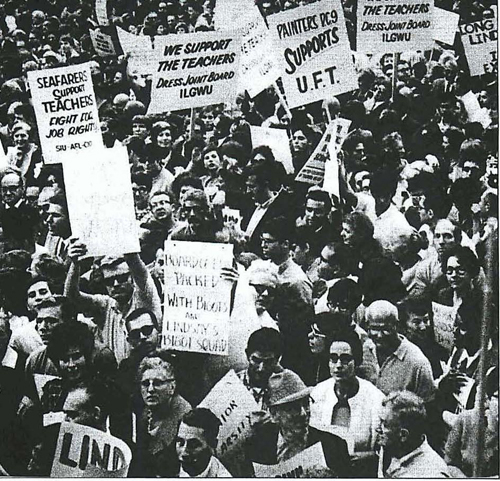New York City teachers' strike of 1968
The Brownsville School Strike, also known as the New York Teachers ' Strike was a labor dispute between the teachers' union, UFT and the city government under Mayor John V. Lindsay in 1968, in which it came to the racial integration and decentralization of school administration in New York City. Due to the strike 85 percent of the 900 city schools for 55 days were closed.
Background
For the American civil rights movement to improve the debt education for blacks was a core concern to achieve equality for the African American population. The integration of schools was there a main concern. Since the beginning of the 20th century were separate but equal strictly by the principle originated by skin color separate school systems. The black school districts had a significantly poorer financial and human resources, so that the educational opportunities for African Americans, and thus the opportunities for economic and social advancement, were significantly restricted. The integration of the school systems was therefore seen as an essential aspect to increase the educational opportunities for blacks to improve in this way their chances of equality. The case of Brown v. Board of Education led to the prohibition of racial segregation in schools by the Supreme Court of the United States. The implementation of racial integration in education led as in the case of the Little Rock Nine often to considerable controversy.
While in New York State, racial segregation in schools was also v. Board of Education officially banned before Brown, but there was a de facto racial segregation by the fact that the black population was concentrated in a few districts, so that the local schools largely attended by blacks were. The school bureaucracy, however, was mostly white and often centralized and highly Jewish, and black parents complained that they did not have sufficient participation rights. Studies found, among other things by the Ford Foundation that it would be psychologically damaging for African-American children when they a pure white faculty and school administrators are confronted and demanded the decentralization of school management and stronger participation rights of the local population.
Course
John V. Lindsay, the progressive mayor of New York City, saw the need for a decentralization of the school system and made, among others, Ocean Hill - Brownsville, two districts in East Brooklyn, where the majority of blacks live, a pilot area for the school decentralization. The new black administrator for the school district, Rhody McCoy, offset 13 teachers and six staff members of the school administration, most of them Jews, from the school district. The teachers' union UFT (United Federation of Teachers ) under the leadership of Albert Shanker considered the dislocations as illegal and called for a strike, during which 85 percent of the 900 urban schools were closed for 55 days. The strike was only ended when the state of New York took over control of the school district and McCoy and the local school administration suspended.
Follow
The Brownsville School Strike had profound implications for the school system in New York City and the relations between Jews and African Americans. During the school strikes there had been hostile, who had both racist and anti- Semitic overtones. The relationship between African Americans and Jews, traditional allies in the fight for more civil rights, was at least disturbed sustained in New York. He strengthened the tendencies in the African American civil rights movement, the integration instead prefer to distance themselves from the white population, in line with the Black Power movement, sat.
An essential element of the strike was the preservation of power of school bureaucracy and its supporting union UFT. A year after the school strike, 1969, the State of New York enacted a law to actually decentralization of the school system in New York City. The agreement of the trade unions, which had been strengthened by the school strike of 1968 was achieved by the union received great influence on the appointment of teaching posts and the school system. The local School Boards were centers of both nepotism and corruption and the efficiency of the school system in New York City eased dramatically, with consequences that are felt to this day. In 1996, parts of the decentralization undone.
Swell
- John Kifner: "Echoes of a New York Waterloo", New York Times, December 22, 1996.
- Strike
- Civil rights
- Racism
- History of the United States (1964-1980)
- History of New York City
- 1968










